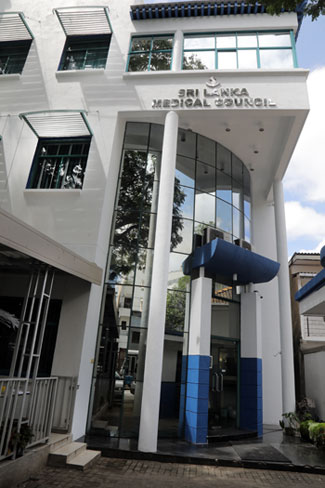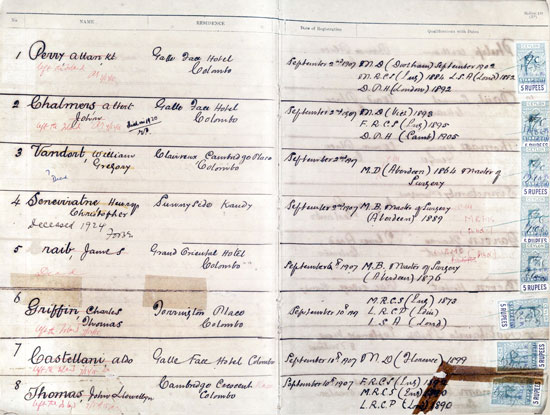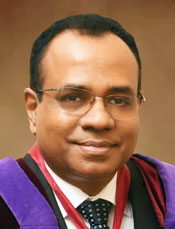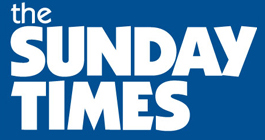SLMC: Into the future with 100 year legacy

Pix by M.A. Pushpa Kumara
Handwritten, smeared and smudged it may be – but the content is proper and in order!
These are the minutes of the very first meeting, a hundred years ago, of the ‘watchdog’ which safeguards the interests of the ill.
It was Friday, June 25th, 1925, the time recorded as 3 p.m. and the place as the Colombo Medical Library……the Chair being taken by President Dr. N.D. Walker.
The first matter that afternoon had been to lay down the Constitution – and with those words was born the Ceylon Medical Council which had a name-change to the Sri Lanka Medical Council (SLMC) in 1972, now based at 31, Norris Canal Road, Colombo 10, a stone’s throw from the National Hospital of Sri Lanka (NHSL).
This robust regulator has over the years weathered many a storm – both ‘internal’ including factional differences among members and ‘external’ such as litigation and political interference. It celebrated its centenary yesterday (July 5) in Colombo with a day’s Academic Session followed by a Commemorative Event graced by Prime Minister Dr. Harini Amarasuriya, Health Minister Dr. Nalinda Jayatissa, SLMC President Prof. Vajira H.W. Dissanayake and Centenary Celebrations Committee Chair Prof. Ranil Fernando.
Amidst a hectic schedule and signing of documents, SLMC Registrar Dr. Hemantha Herath sat with the Sunday Times early this week to peer back into the dim mists of time and also look towards the future.
Interestingly, back in 1925, that first Registrar Prof. F.O. Ellison who had not just served for one but 13 years (June 1925-June 1938) had been given the task of signing all routine documents.
The minutes of yore also state: The Registrar applied to the Council for payment for work done in connection with the election of the Council.
It had been proposed “that Government be asked to make this payment as it was done on their request, not on that of the Council which was not then in being”. An amendment proposing “that as the Government grant of Rs. 1000 for the year 4th December 1924 to 4th December 1925 has been paid to the Council’s account, the Council do pay for this work done during this period” had been carried by a majority.

The first page of the Register
 Fast forward 100 years, busy as bees they may be, but Dr. Herath’s staff is quick to provide the historical background we need with regard to a “legacy that has profoundly shaped the country’s healthcare landscape”.
Fast forward 100 years, busy as bees they may be, but Dr. Herath’s staff is quick to provide the historical background we need with regard to a “legacy that has profoundly shaped the country’s healthcare landscape”.
The origins of medical regulation in Sri Lanka trace back to 1870 when the Colombo Medical School was established, admitting 25 students, and 10 years later (1880) evolved to the Ceylon Medical College, laying the groundwork for formal medical education. The qualification these students secured was a diploma of Licentiate in Medicine and Surgery (L.M.S.) which was registered with Britain’s General Medical Council, without further examination.
With the Medical Registration Ordinance coming into being in 1905, those armed with the L.M.S. (Ceylon) had been registered by the Ceylon Medical College Council (CMCC) which also had the power of ‘erasure’ of the name of a registered person.
As the need for a regulatory body to oversee medical practice arose, the Ceylon Medical Council had been formed in 1925 under the Medical Ordinance, to maintain standards of medical education and practice, ensuring that only qualified individuals served the health needs of the populace.
Gradually, apothecaries and estate dispensers, followed by dentists, midwives, pharmacists and other allied health professionals had been registered.
When the University of Ceylon was set up under the University Ordinance of 1942, the MBBS (Bachelor of Medicine, Bachelor of Surgery) degree and the BDS (Bachelor of Dental Surgery) degree had been recognized for registration.
Later, others brought under the registration mandate included Sri Lankan citizens who have obtained a degree or diploma from a medical school outside Sri Lanka, following a special examination (ERPM – Examination for Registration to Practice Medicine and ERPDS – Examination for Registration to Practice Dental Surgery) and para-medical assistants such as radiographers, medical laboratory technologists and physiotherapists.
Even though between 1949 and 2005, nurses had also been registered by the Ceylon Medical Council, now that power lies with the Sri Lanka Nurses’ Council.
A recent highlight, meanwhile, has been the registration of Dental and Medical Specialists since 2018.

Current President: Prof. Vajira H.W. Dissanayake
Seen as the ‘cornerstone’ in ensuring competence, ethics and professionalism in this sector, the SLMC currently has 34,355 ‘active’ registrants of medical practitioners, 2,398 dental surgeons and many more.
For Registrar Dr. Herath, the rapidly-changing medical and technical landscape is a major challenge. As legal institutions did not have adequate mechanisms to address the fallout of digitalization, the SLMC has drafted a new Medical Bill which is now with the Health Ministry.
Referring to the SLMC’s own digital transformation, he says they have implemented electronic registration systems, digital document archiving and online renewal processes, while other challenges including litigation issues have been addressed by recruiting a well-qualified lawyer and strengthening the legal unit.
Focusing on the pursuit of excellence, he says that the SLMC established the Accreditation Unit to ensure that medical institutions adhere to rigorous standards. In 2023, the accreditation programme received recognition from the World Federation for Medical Education (WFME).
He also reiterates that the SLMC, through its disciplinary procedures and guidelines, has fostered accountability and integrity. By addressing professional misconduct and promoting continuous professional development, it has reinforced ‘public trust’ in the healthcare system.
Into the future looks Dr. Herath as he says: “The centenary is not only a celebration of past achievements but also a reaffirmation of the commitment to safeguarding the health and well-being of Sri Lankans. With a vision for continuous improvement and adaptation, the SLMC is poised to navigate the future of healthcare with the same dedication that has defined its first century.”
Searching for an ideal partner? Find your soul mate on Hitad.lk, Sri Lanka's favourite marriage proposals page. With Hitad.lk matrimonial advertisements you have access to thousands of ads from potential suitors who are looking for someone just like you.


